|

|
|
|
21.3 Differentiation of the gonads
|
|
|
Displacement of the ovaries
|
|
|
|
The ovaries are also moved slightly - from the location where they are engendered in the middle of the abdomen to the pelvis. This migration results partially from the massive growth of the upper abdominal region in comparison with the pelvic area.
The influence of the lower gubernaculum in this process is not entirely clear.
|
|
|
|
The mesonephros atrophies in the 7th week. Only the ovary with its mesovarium medially and the paramesonephric duct (later fallopian tube) with the mesosalpinx lateral to the meso of the original urogenital tract remain. They are connected with the dorsal abdominal wall of the embryo via the meso of the original urogenital tract.
|
|
|
Fig. 27 - Displacement of the ovary
at the beginning of the 3rd month |
|
Fig. 28 - Displacement of the ovar
at the end of the 3rd month |
|
Legend |

|
|
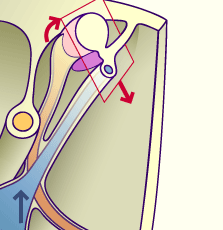
|
|
|
Fig. 27
Originally, the urogenital tract finds itself in a vertical position.
Fig. 28
Through a sideways tipping displacement the ovary finds itself temporarily above the atrophying mesonephros.
|
|
Illustration
|
|
Overview drawings with captions
|
|
|
|
Fig. 29 - Displacement of the ovaries
at the beginning of the 4th month |
|
Fig. 30 - Definitive position of the
ovaries at the end of the 4th month |
|
Legend |
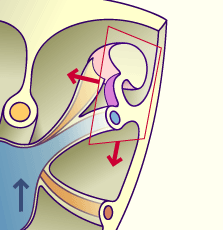
|
|
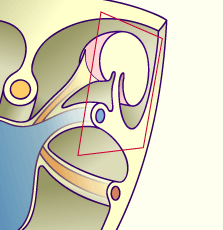
|
|
|
Fig. 29
The ovary now tips backwards. The fallopian tube, which forms from the cranial part of the paramesonephric duct (Müller), is pulled medially by the joining of the distal parts of the paramesonephric duct on both sides and thus takes on a horizontal position.
Fig. 30
Definitive, dorsal position of the ovary
|
|
|
|
|
Through atrophy of the mesonephros the upper gubernaculum connects the ovary directly with the upper rear body wall and becomes designated as the suspensory ligament of ovary.
The lower gubernaculum has its origin in the bottom side of the ovary and forms the ovarian ligament and, further down, the round ligament of uterus that reaches the genital swelling (labia majora) through the inguinal canal.
The nephrogenic cord is originally vertical. The fallopian tube, which forms from the upper part of the paramesonephric duct (Müller), finally takes on a horizontal position in that it is drawn medially by the joining of the lower part of the paramesonephric duct (Müller) as the uterus is being formed.
The ovary, which initially lies medially to the fallopian tube (paramesonephric duct) in front of the atrophying mesonephros, slides backwards as a result.
|
|
|
The peritoneal mesos passively follow these movements. Finally the broad ligament of uterus forms with three sections:
- Upper section: mesosalpinx with the fallopian tube
- Ventral section: mesometrium with the round ligament of uterus
- Dorsal section: mesovarium with the ovarian ligament.
|
|
Fig. 31 - Formation of the broad
ligament of uterus, ca. 8 weeks |
|
Legend |
|
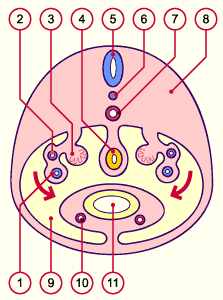
|
|
Fig. 31
Transverse section through an embryo: The two paramesonephric ducts (Müller) approach in the middle. The mesonephric duct (Wolff) and the mesonephros are still clearly visible at this stage.
|
| Fig. 32 - Formation of the broad ligament of uterus, ca. end of the 8th week |
|
Fig. 33 - Formation of the broad
ligament of uterus, ca. 10 weeks |
|
Legend |
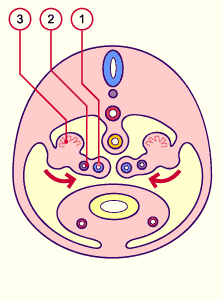
1
2
3
4
5
6 |
Paramesonephric duct (Müller)
Mesonephric duct (Wolff)
Ovary
Intestine
Neural tube
Notochord |
|
|
|
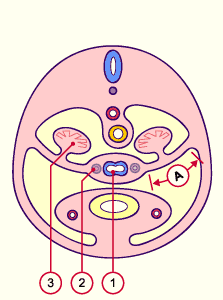
7
8
9
10
11
A
|
Aorta
Mesenchyma
Coelomic cavity
Umbilical artery
Urinary bladder
Broad ligament or mesometrium |
|
|
|
Fig. 32
Transverse section somewhat later and more caudal. Observe how the mesonephros has atrophied (across from the ovary). The paramesonephric ducts are almost fused.
Fig. 33
Transverse section showing the fusion of the paramesonephric ducts to form the utero-vaginal canal. The mesonephric duct has atrophied and the broad ligament of ovary subdivides the pelvic space in the 10th week.
|
|
|

